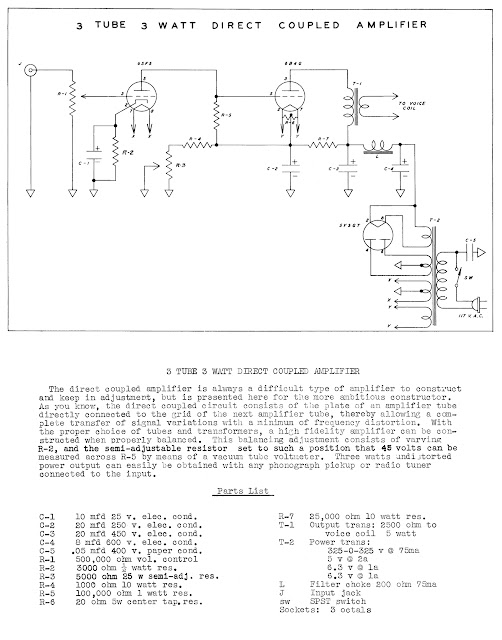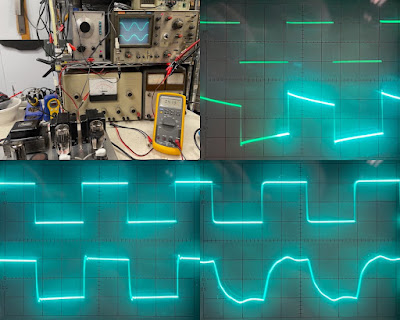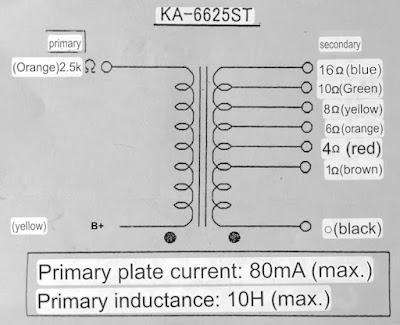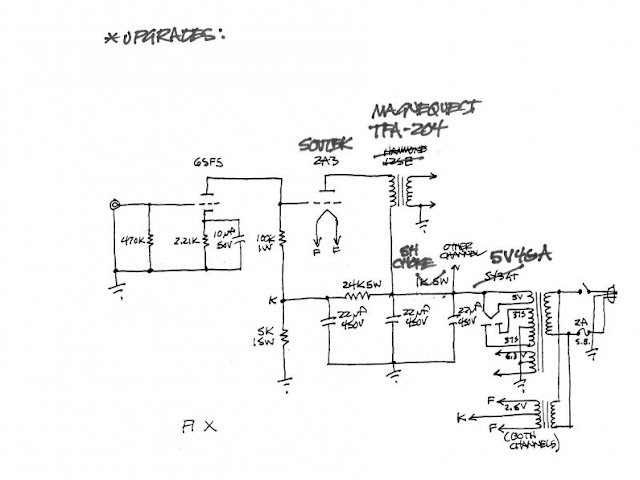My first exposure to Don Garber's Fi 2A3 amp was at a gathering of burgeoning SE-DHT/High Efficiency speaker enthusiasts organized by Mike LaFevre of Magnequest and Peter Breuninger, then president of the Philadelphia Audio Society. This was held in the outskirts of Philly during the latter part of 1994. I attended to assist my friend Steve Melkisethian in exhibiting the Audio Note Kit 1 amplifier since he was the US distributor of Audio Note UK Kits, transformers and parts at that time. Sadly, these guys are no longer with us. 😔
 |
| Robin and Lipman SE 6B4G |
In spite of my reservations about the Klipsch La Scala speakers (flame suit on 😉) chosen for the demo, the amp which impressed me the most at that event was Don's Fi 2A3 with Magnequest DS025 OPTs. When Don mentioned that it was a direct coupled circuit using a 6SF5 input tube, I was quickly reminded of the SE6B4G schematic above from the book Practical Amplifier Diagrams by Robin and Lipman at the Angela Instruments library.
This hand-drawn schematic by Don Garber has been floating around the internet since his demise in 2017. Don was an old-school gentleman who commanded respect because of his unassuming and genteel demeanor. He was a man of impeccable taste, not only in music, but also in art and architecture. I enjoyed Coltrane and Miles LPs spinning on his Garrard 301/SME 3012/V15-IV when I hung out at his 30 Watt Street SoHo NYC Fi shop. But he also made it a point to play his favorite LPs of the Juilliard and Guarneri string quartets because he knew I had studied with them. Given his stature, the origin of his Fi 2A3 circuit may have been a well-guarded secret within the Sound Practices community.
 |
| An early Fi 2A3 + Magnequest DS025 OPTs |
It's been over seven years since Don left us and I've been wanting to hear this Robin and Lipman-derived amp again. After much soul searching, I convinced myself that building an amp based on Don's sketch and blogging about it would be my way of honoring his legacy as one of the prominent influencers during the SE-DHT/High Efficiency speaker movement of the 90s.
!!!WARNING!!!
The voltages in this project are potentially lethal!
Proceed at your own risk!
I didn't slavishly try to replicate Don's schematic. In typical DIYer manner, I used what I had available from my parts bin, starting with a 700VCT @ 150mA power transformer. The output triodes are heated by separate 2.5V/3A filament transformers + 50Ω, 2W wire wound hum pots, which keep hum/noise below 3mV, and electrolytic capacitors were employed in the power supply instead of Don's preferred Solens. By changing the rectifier to a 5Y3, a 45 triode output tube can be substituted as long as the cathode resistor value = 4.7k, 20W.
 |
| From Sound Practices Issue 15 Thinking that I can always acquire another pair, my cherished Magnequest TFA204s went to a friend's listening room in Manila. Those were my favorite OPTs from Mike L's workshop and enjoyed them even more than the pair of RS025s (DS025 with higher grade M4 lams) I also owned. When Tish and I moved to the Philly area, I asked Mike if he could wind another pair of TFA204s. A few months later he was gone...I didn't know he was ill.😔 |
In lieu of the TFA204s, I used a pair of PMF10WS output transformers which have 3.5k (7k) and 2.5k (5k) primary taps. I installed a switch to match the primary impedance to the chosen output triode/tube rectifier combination.
WARNING: TURN OFF THE AMP BEFORE SWITCHING PRIMARY TAPs!
Using Ohm's Law, I = V/R, wherein I = current, V = voltage and R = resistance, we can calculate the plate dissipation for the chosen output tube/rectifier tube. For example: using a 45 tube + 5Y3 rectifier (voltages in red), cathode voltage: 150V/resistance: 4700Ω = 32 mA current (I), still below the 36 mA maximum for a 45. Now let's compute the plate dissipation, plate voltage = 380 (voltage at plate ) - 150 (cathode voltage) = 230V (plate voltage), 230V x .032 (tube current) = 7.36W, well below the 45's 10W maximum limit!
If we do the same calculation for the 2A3 (voltages in blue), we get a 9.4W plate dissipation for the 2A3, which is still within the operating point of a 45 triode.
To get closer to textbook 2A3 operating point (voltages in black in the above schematic), I changed the cathode bias resistor to a 3k, 50W. Now the 2A3 is drawing 52mA with a plate dissipation of 13.5W, which is closer to the standard 15W tube manual recommendation. Power output is up to 2W per channel from barely 1.5W with the 9.4W plate dissipation. Although in this configuration, the 45 output triode + 5Y3 rectifier is no longer an option because the maximum plate dissipation of the 45 triode will be exceeded.
 |
| JEL/Fi 2A3 Tribute amp (3k, 50W cathode bias resistor) power @ clipping = 2 Wpc into 8Ω/0.66Vrms 1 kHz sine wave input Frequency response @ 1W = +/- 1 dB 20 Hz - 15 kHz Noguchi PMF10WS OPT |
JEL/Fi 2A3 (4.7k/20W K-bias resistor + PMF10WS) Tribute amp driving Altec 406-8Ys in Coronado cabinets + OJAS 1211 horns/Coral M100 compression drivers in this Stanley Turrentine track
1500 milliwatts per channel output is plenty of power for most of my listening requirements since all my speaker systems present a practically resistive load with rated sensitivities ranging between 92dB-99dB/2.83V/M.
Michel Petrucciani played back via JEL/Fi 2A3 (@ close to 15W plate dissipation) + PMF10WS Tribute amp driving Altec 755As in Silbatone cabinets on tulip speaker stands courtesy of my friend Phil 🙏 whose main amp is a Fi X commissioned directly from Don in 2000
45 and 46 output tubes
Being a formally trained classical musician, my bottom line in this hobby has always been to build projects that can play music that stir my soul! Therefore, I'm not easily swayed by tech savvy-types equipped with circuit simulation software who discourage potential DIYers from using low current high gain (hi-mu)/low transconductance (lo-gm) triodes like the 6SF5 and its variants - 75, 6F5, 6SL7, 7F7, etc. or even 6C6, 6J7, 6SJ7 pentodes because of Miller effect and etc.
OTOH, I also admit that putting theory into practice can also lead to musically rewarding results! For example, the dual grid 46 is a very rugged tube and as others have done, I pushed it beyond specs in triode mode close to 45 operating points. It produced a little bit more power and looked prettier on the scope but it sounded too mushy for my taste. When I adhered to its published tube manual specs, I started to appreciate its unique sonic character, which brought back memories of when I first tried the 71A, 10, VT-2 and WE205D DHTs. Therein lies the beauty of DIY - build, listen and if you like what you hear, then it's good! If not, try tweaking and if that doesn't work, start another project. That's how I learned and I continue to fill the coffers in my mind's ear by building and listening! 😊
To accommodate triode strapped 46 output tubes, I transferred the PMF10WS OPTs to another chassis already fitted with a power transformer that has a 580VCT @ 125mA HT rail. For kicks, I substituted the 6F5 for the input, which is electrically the same as its immediate successor, the 6SF5, albeit with a cool grid cap. With the proper output tube + rectifier pairing, this chassis fulfilled the parameters found in the preceding tube manual scans.
 |
| 45 output tubes + 5AR4 rectifier PMF10WS OPT reflecting a 5K pri. Z Output = 1000mW per channel +/- 1 dB 30 Hz - 15 kHz @ 1W |
 |
| Triode strapped 46s + 5Y3 rectifier PMF10WS reflecting a 7K pri. Z Output before clipping = 390mW per channel +/- 1 dB 40 Hz - 15 kHz @ 390mW |
Despite the pathetic numbers and dreadful-looking 10 kHz square waves, I was really enjoying the amp in either configuration. Since this design doesn't leave much room for tweaking, I left it alone. Truth be told, I prefer lounging in my man cave engulfed in melody, harmony and rhythm rather than perched on my test/work bench stool.
If you're still on board, you may proceed to the 5-pin to 4-pin tube adapter video below.😉
I hope you find this video on how to DIY a 46 to 45 tube adapter useful! 😊
 |
| JE Labs Tribute to Fi 46 amp with Noguchi (now General Transformer) PMF10WS OPTs |
The triode strapped 46/5Y3 combination offers a mystifying and intimate perspective. It also sounds significantly more powerful than the static scope test indicate.
Abbey Lincoln singing via the 390 mW per channel JEL/Fi 46 Tribute amp driving Altec 755Cs in Silbatone cabinets + Altec 3000H super tweets
If you like the delicacy of an atmospheric mid to back hall presentation, plug in the 45s + a 5AR4 rectifier.
The JEL/Fi 45 Tribute amp playing Requiebros by Gaspar Cassado arr. for piano trio by my friend and colleague, Albert Tiu on the piano, cellist, Sean Katsuyama and yours truly, violinist.
Before leaving this section, I tried another experiment. I replaced the 45 DHTs with 2A3s and retained the 5AR4 rectifier.
PMF10WS-wvs.jpg) |
| 2A3 + 5AR4 rectifier (45 operating point) PMF10WS OPT 5K reflected primary Z Output = 1.89 Wpc (8Ω tap loaded with16Ω) +/- 1 dB 30 Hz - 15 kHz @ 1W |
Usually an SE amp clips asymmetrically, the symmetrical 1kHz sine wave at onset of clipping is atypical. I mistakenly loaded the 8Ω tap with a 16Ω resistor. By the time I realized my error I was already in listening mode and too lazy to retest. 😉
JEL/Fi 45 Tribute amp with 2A3 output tubes driving Altec 755Cs in Silbatone cabinets augmented on top by Altec 3000Hs playing The Beach Boys
The 2A3 @ 45 operating point sounds somewhere in between the silky smooth and detailed 45 and the more dynamic + larger scale presentation of a 2A3 operating close to 15W plate dissipation.
FINALE
 |
| Kasuga Wireless KA-6625ST (discontinued) |
I didn't want to leave the chassis fitted with the 700VCT @ 150 mA power transformer without output transformers so I installed a pair of budget Kasuga Wireless KA6625STs, which are now sadly discontinued. I also wanted to hear whether another transformer would make a dramatic difference. Besides, I can never have too many amplifier flavors at my disposal.😊
 |
| KA-6625ST wiring diagram + specs |
This output transformer is similar to the Hammond 125ESE such that it can be configured to reflect different primary Zs facilitated by the multiple taps in the secondary. For example: by connecting a 16Ω speaker to the 10Ω secondary tap or 8Ω to 6Ω secondary tap, the reflected primary Z will become 3.5K instead of 2.5K and so forth. Some contemporary transformer manufacturers eschew this practice for technical reasons, to the extent that there are suppliers who only provide one secondary tap.
As I had mentioned in a previous blog entry, the Japanese audio community pioneered the rediscovery of single-ended DHT amps and have been producing quality air-gapped SE transformers since the 70s. That's a couple of decades ahead of North American and European manufacturers who only re-tooled in the 90s. By providing multiple taps in the primary and secondary, IMHO and experience, the Japanese makers have a better grasp of how to serve the needs of curious audio experimenters and DIYer's!👍
FWIW, Don also offered his amps with Hashimoto output transformers and I have seen units fitted with Tamura and Tango.
 |
| JEL Fi 2A3 (3k/50W K-bias resistor) Tribute amp + Kasuga Wireless KA6625ST OPT +/- 1dB 30 Hz -15 kHz @ 1W Power before clipping = 2 Wpc |
The KA 6625ST output transformer shows better top end response whereas the PMF10WS (see first oscillogram at the top) has a slight advantage in the low end because it has more metal. To my ears and in this context, the difference was quite insignificant and not worth splitting hairs over.
That said, I've used the KA6625ST OPTs with a 2A3 driven by a plate choke loaded 7193/2C22, and that amp subjectively produced better extension and definition in the low end, wider bandwidth + dynamics than this direct coupled circuit. In fact, I also hear slightly more bass fundamentals from my Radiotron SE2A3 amp fitted with bonsai Finemet FM6WS OPTs.
Keep in mind that an amp = the sum of its parts: tubes + circuit + iron, and compromise went into the design of each of those parts. Hence, it'll never be perfect!
 |
| JE Labs Tribute to Fi 2A3 amp with Kasuga Wireless KA 6625ST OPTs |
Don's Robin & Lipman-derived circuit exemplifies a topology derided by experts - all of the permutations I tried above failed to meet tube manual specified output power perhaps due to the 6F5/6SF5 triode's relatively weak current drive ability. Through the decades, I've built the Simple 45/2A3, SRPP 45/2A3, cascaded 76/6SN7 > 2A3, 6SL7>CF>2A3 (aka 2001 ed), Radiotron SE2A3, original + reimagined morrison micro and choke-capacitance coupled 2A3. They all met (or got pretty close to) their power output specifications before clipping, except this. Yet this minimalist DC circuit still delivered what counted most - make music! It has an alluring transparency from 80 Hz to 7 kHz encompassing the entire human vocal range as well as the fundamentals of most acoustic instruments. I was reminded of my experience hearing a Western Electric 15A horn with a 555W driver. That was magic!
It's all about the music folks! Hopefully someday audio engineers will design software that can analyze and explain what type of musically consonant distortion makes this possible. Otherwise, what's the point? 😊
The elegant simplicity of this circuit and its sonic lucidity personifies Don Garber, the sound artisan!👏









Hi Joseph, thanks so much for this post. I am a big fan of Don's and have his 300B mono blocks. I am wondering if you have recommendations on OPTs that are still in production and relatively easy to obtain that are good substitutes for this build?
ReplyDeleteAFAIK, Don used a direct coupled 6SN7 circuit for his 300B amp (but never saw an actual schematic), which is different from the one in the above article.
DeleteThat said, I have used the Hashimoto H30-3.5S OPTs successfully in a pair of SE300B mono blocks for this project - https://jelabs.blogspot.com/2022/01/a-cousins-listening-room.html - my cousin is very delighted with that set up and has focused on merely expanding his LP collection!
If you are in the US, I recommend contacting Mr. Asakura at this webpage - http://www.tube-amps.net/Hashimoto_Products.htm - he's based in Michigan.
As mentioned (hyperlinked) above, Don was offering his amps with Hashimoto OPTs as upgrade. For ex: Fi stereo 300B amp with Hashimoto H30-3.5S - https://jeffsplace.positive-feedback.com/integrated-300b-stereo-amp-prototype-don-garber-beautiful/
I hope that helps!
Thanks for this!
DeleteI was asking about possible alternative OPT for the 45/2A3 build in your post. Any recommendations?
If you like to experiment (2A3/45/46 + different taps), I highly recommend the Noguchi (now General Transformer) PMF15WS - https://www.gtrans.co.jp/SHOP/PMF-15WS.html I reviewed the Noguchi version here - https://jelabs.blogspot.com/2017/02/budget-se-opts-edcor-and-noguchi.html - that offers greater flexibility and slightly better specs than the PMF10WS above.
DeleteI've ordered directly from the G-Trans website using a translation app and everything went smoothly with fast shipping. But that was a couple of years back.
If you're concerned about tariffs, check out Asakura-san's HC203U, I reviewed it here - https://jelabs.blogspot.com/2013/12/hashimoto-hc-203u-se-output-transformer.html and also the H203S -https://jelabs.blogspot.com/2019/04/hashimoto-h-203s-from-kasuga-wireless.html (see above on how to reflect a 5K + 7K primary )
The HC203U offers better performance at the extremes due to more metal, however, the smaller H203S uses higher grade C-core which produces a more vivid midrange.
If you want HC203U bandwidth + H203S mids = H20-3.5U.
Good luck!
Hi Joseph, coincidentally I started a two stage direct coupled amp a couple months ago. Inspiration came from Don's Fi but it's a bit different given I'm only using parts on hand. I do not have Fi tubes but I have E810F's, 46's, and 6BY5 rectifiers.
ReplyDeleteReferencing Don's 2a3 "Upgrades" schematic, the cathode is tied to the power supply filtering to the 6SF5 - or maybe it's best to say the cathode IS the power supply final filtering. You did the same in your 45/46 Fi Tribute amps. I'm going the traditional cathode resistor and bypass cap route - both to ground / separate from the PS - particularly since I have one supply for both channels.
Just curious... why did he not utilize a "traditional" cathode scheme? (I did notice the Fi amp uses two less capacitors than "traditional")
Thank You, Joe
Hello Joe,
DeleteThanks for stopping by! As you probably know I'm not a formally trained engineer, just a long time hobbyist who played the violin for a living for decades. ;) Anyway, I'll try to answer the best I can.
Based on your description, your circuit is closer in nature to the morrison micro featured here - https://jelabs.blogspot.com/2021/06/reimagined-morrison-micro-2a3-kasuga.html - wherein the paralleled 6SL7 input/driver stage is supplied by the same B+ rail downstream from the output section, not from the filament (cathode) of the output triode.
AFAIK, the Robin & Lipman circuit from which Don's Fi schematic is derived, are variations of the original Loftin-White circuit published in 1929. In this case, the input/driver tube's B+ supply is connected to the filament (cathode) of the output.
For more info re: Loftin-White circuit - https://www.ispra.net/audio/DCSingleEndedAmplifier/index.php - if memory serves, this was published in the Spring 1994 issue of Sound Practices.
Another worth while read is J-Rob's article on 2A3 amp circuits in which Nobu Shishido's DC 2A3 was discussed -https://www.enjoythemusic.com/magazine/sound_practices/15/never_met.htm
Happy reading and listening!
Thank You Joseph. I forgot about the Joe Robert's article and JC Micro. I bought my set of sound practices thru ebay - well after you received them in the mail :-)
DeleteMaybe I'll see you at a future Kutztown radio show!
-Joe (west chester, pa)
Nice to know we're in the same metro area. I look forward to meeting you at Kutztown!
DeleteSorry, one more thing that I think is worth pointing out with Don's designs... the layout of his amps - the mono block 2a3 in particular. Left side is 2a3 and OPT behind - right side is rectifier and 90 deg turned PT behind. Left side and right is offsetted. Driver tube is in the far back (right) - makes for a super short wire to the input jack. To me it's a great example of a well thought out layout. I fell for it when I saw it - mine is a stereo amp - "left" side has two channels.
ReplyDelete-Joe
Excellent write up! I built my tribute amp a few years ago with bigger wider bandwidth FM-14WS OPT’s. I settled on the 46 over a three month period as I preferred it over the 45 & 2A3. Tip- the Sony PT out of the TC-500 RTR decks are the perfect drop-in PT and less than $100. A heavenly sounding amp from 80hz-10Khz!
ReplyDeleteThanks! I've recycled Sony RTR iron, good stuff.👍
Delete